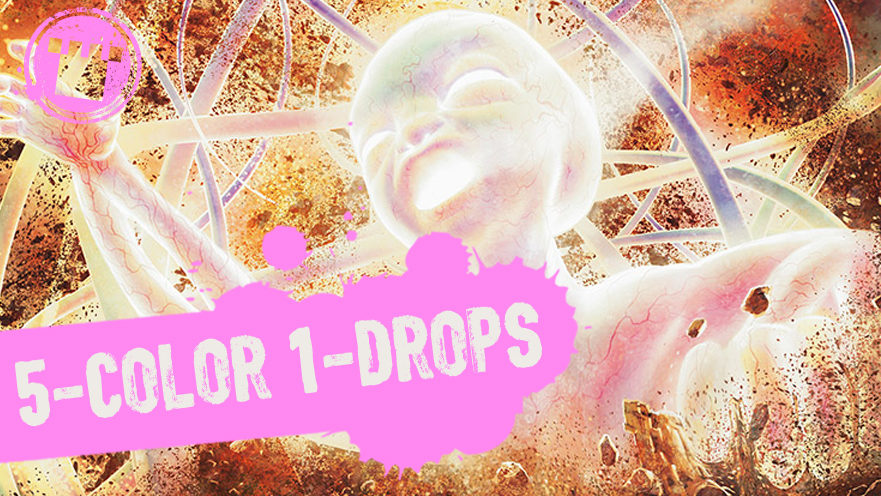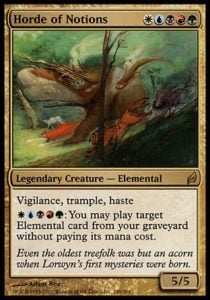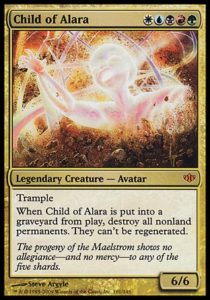For all the deckbuilding, winning, or not winning that we do, the biggest reason we should love Commander is not just for the achievements we unlock ourselves, but also for the ability to excite and inspire others.
One of the deck archetypes that has inspired me most over the years has been Five-Color One-Drops. Five (completely coincidental number) years ago, this deck was sent in by a listener to a Commander podcast I liked to listen to, and it’s really stuck with me. At the time, I was struggling to get decks to work well, let alone find working themes, so this take was not only fresh, but also impressive and powerful.
Over time, the options, approaches, and occasional Internet rumblings generate a buzz for this great design, and today, I’m going to give this sweet deck a fresh coat of paint with my take on it.
THE ORIGINAL DECK
View this deck on TappedOut.
Buy this deck from Card Kingdom.
Designed by Coda from the One General to Rule Them All blog back in 2012, the deck features Horde of Notions at the top of a tight, grindy toolbox. Driven by card advantage, we can see finishers in burn spells like Banefire, Devil’s Play, Red Sun’s Zenith, and Bond of Agony, but it’s likely that these cards are not enough to win a multiplayer game. If we want to cast these powerful spells, we have to be patient and play the long game.
It’s important to note that there’s a natural tension between this deck’s mana curve and its mana base. Typically, we want more mana and ramp to swell our burn spells and continue to go downhill at our opponent(s). With 34 mana sources – light by Commander standards – we can hit all our land drops sometimes, but not consistently.
Hence, the deck requires intricate piloting, which I personally like. The uncertainty of how you’re going to win makes playing the game exciting, and in this case, makes the deck that much more exciting. Our spells are cheap, but we’re always going to have things to do. This is reinforced by not only strong buyback spells such as Wurmcalling, Whispers of the Muse, or Spell Burst, but also by our mana base, which features the Worldwake creature lands. My favorite is probably Lavaclaw Reaches, which can do some serious work on a creatureless board.
We have just enough tutors to find cards we want, the cheekiest and most mana-intensive being a transmuted Dizzy Spell, which isn’t going to be cost-prohibitive when the card you’re getting can be played on the same turn. And although it’s normally a pariah, Sensei’s Divining Top is a particularly fashionable, restriction-friendly card advantage option. It fits because it is vital to ensuring the deck plays a normal game of Magic, not just as extra credit for control decks.
Creature-wise, the deck has plenty of combat power and effective card advantage. Filled with Hydras, Mikaeus, the Lunarch, and Figure of Destiny, we have plenty of mana sinks to grow big, scary threats, while Veteran Explorer and Weathered Wayfarer can ensure we’re playing lands. Hex Parasite is also a nice way to deal with Planeswalkers, and rounds out the suite of answers to troublesome permanents.
THE UPDATE
View this deck on TappedOut.
Buy this deck from Card Kingdom.
With five years’ worth of additional one-drops in circulation, there’s plenty of room for improvements and substitutions, as well as nuanced stylization, for anyone looking to take on this deck design challenge.
From the top, I chose Child of Alara over Horde of Notions because it cleans up clogged board states while providing a similar threat level. This favors my playing style a little bit more as well, as I don’t necessarily want to attack every turn. Using Child of Alara necessitates that we make some changes to the original design, but we’re still playing a very similar core for card advantage— we’re just adding more recursion to reinforce our powerful engines!
The biggest changes are to the mana base, trimming it from 34 to a very narrow 29. The main reason for this is an uptick in function and mana efficiency. In playtesting, I found that the abundance of extra creature lands could be replaced with Battle for Zendikar’s rare land cycle for budget as well as function. We’re not playing a lot of tap lands, so they function slightly better than core set duals or Ravnica shocklands. I also added Exotic Orchard for extra fixing, but the most vital inclusions are Academy Ruins and Volrath’s Stronghold. Together, they help us to power out mana while we continue to remove troublesome permanents and replay our own threats.
In this way, the deck has taken a turn toward control, with an emphasis on card quality. Flavor favorites like Chained to the Rocks and Dispatch add to an already great suite of white removal cards, while rule-benders Wear-Tear, By Force, and Heaven//Earth are upgrades from cards like Simplify, Shattering Spree, and Vendetta.
Child of Alara and Volrath’s Stronghold also prompted me to run a tighter, more focused creature base. The newcomers are Caustic Caterpillar, Kytheon, Deathrite Shaman, and Hypnotic Siren, the last of which is my favorite piece of tech in this list. Kytheon is also worth mentioning, as he provides us with a fun one-drop Planeswalker that we can protect. Oviya Pashiri is my budget option for Rhys the Redeemed, though both might want to come in so we can re-introduce Green Sun’s Zenith, which was cut because I didn’t think there was enough utility value to include it.
CONCLUSION
Should we be allowed to play our Commander? Should we be allowed to play X spells? What about zero-cost spells?
These are just a few of the conversations I’ve had with people about the one-drop creature restriction, and it’s been really entertaining. I’ve had talks with one-drop purists who believe Progenitus is the only acceptable Commander for this deck because our low curve and few mana sources make him nearly impossible to cast. I’ve also cut zero-cost spells from my list after people who said the deck seemed too “binary.”
Point is, this restriction is both an excellent thought exercise, and a tremendously challenging deck to build and play, whichever way you choose to go. While I think Progenitus, Horde of Notions, and Child of Alara are still the best options, I hope this inspires you to prove me wrong with Ramos or O-Kagachi, or just to simply jam your favorite one-drops together and see what they can do.
Header design: Justin Treadway
Header image: “Child of Alara” by Steve Argyle

For most of his Magic-playing life, Aaron has been playing and writing about Commander. One of the few mono-colored players in a gold-bordered world, Aaron enjoys the challenges of creating meaningful, memorable games, as well as the excitement that comes with engaging underrated cards as he explores the format’s uncharted territory. A disciplined deckbuilder with over 200 lists to his name, Aaron has spent the past several years creating content about his favorite format.



